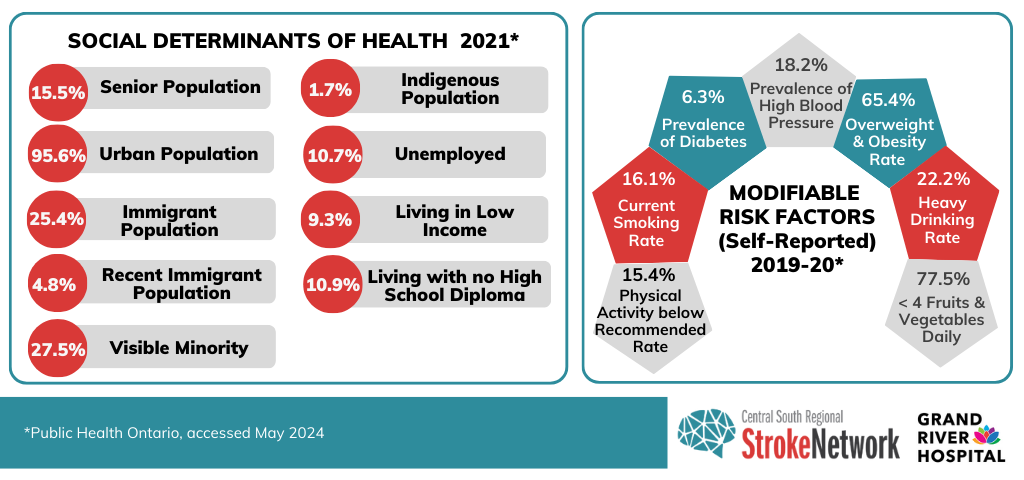At Waterloo Regional Health Network (WRHN), we take pride in the services and care we provide. We believe it is important to share our performance with patients, families, and the communities we serve. Sharing openly helps hold us accountable to provide the best possible care and fosters growth and innovation.
2024 Highlights from April to September
Emergency Stroke Care
A stroke is a medical emergency that happens when a blood clot blocks a blood vessel in a patient’s brain. Nearly two million brain cells die every minute after a stroke starts (Saver, 2006). For the best chance of recovery, stroke patients need to be treated as quickly as possible.
At WRHN, we aim to shorten the amount of time between when a stroke patient arrives at the Emergency Department and when they get medicine that treats blood clots. This is called “door-to-needle time.” From April to September 2024, we reduced our median door-to-needle time from 51 minutes to 43 minutes. This improvement saved approximately 16 million brain cells per stroke patient.
Acute (Critical) Stroke Care
Stroke units provide evidence-based care for patients after a stroke. These units are staffed by teams made up of many kinds of health-care workers with specific skills and knowledge about stroke care. Patients experience fewer complications and recover better when they are treated on a stroke unit.
In 2024, 882 patients were admitted to WRHN’s stroke unit for a sudden (acute) stroke or transient ischemic attack (a brief stroke-like attack where symptoms resolve within 24 hours). Of these patients, 97.3 per cent received care on a designated stroke unit.
Stroke Rehabilitation
Rehabilitation helps patients rebuild their strength and independence after a stroke. Direct inpatient rehabilitation therapy is active, in-person treatment monitored or guided by a therapist. It plays an important role in recovery and can improve a patient's mental abilities and mobility and help them with completing daily living activities.
WRHN @ Chicopee, our stroke team spends a median of 85.6 minutes doing direct inpatient rehabilitation therapy with each patient daily. This is an improvement from 81.3 minutes during the previous quarter. In the Central South Regional Stroke Network, WRHN @ Chicopee is a leader in direct minutes of therapy and outcomes achieved post stroke (Functional Independence Measure or FIM).
Population Health and Stroke in the Region of Waterloo
WRHN provides important stroke services at both campuses. WRHN @ Midtown is a District Stroke Centre for Waterloo-Wellington within the Central South Stroke Network. It provides emergency and acute (critical) stroke services, as well as stroke prevention services. WRHN @ Chicopee provides rehabilitation and helps patients re-enter the community after a stroke.
The following infographics provide a snapshot of stroke care and the communities’ general health in the Region of Waterloo at different points over the past five years.

In 2022–23, the adult population in the Central South Ontario Region was 1,900,000 and saw 3,910 critical (acute) stroke admissions, with 646 of those stroke admissions in the Region of Waterloo.
In 2023–24, the Region of Waterloo had a 94.2 per cent secondary prevention referral rate, an 11.2 per cent thrombolysis treatment rate, and a 97.6 per cent acute stroke unit admission rate, with 25.4 per cent of stroke patients transferred to inpatient rehabilitation. During this same year, the Hospital saw 2,706 Stroke Prevention Clinic visits, 880 acute stroke admissions, 215 stroke rehab admissions, and 4,124 outpatient rehabilitation therapy visits.

In 2021, the Region of Waterloo was made up of the following: 15.5 per cent senior population, 95.6 per cent urban population, 25.4 per cent immigrant population, 4.8 per cent recent immigrant population, 27.5 per cent were a visible minority, 1.7 per cent Indigenous population, 10.7 per cent were unemployed, 9.3 per cent were living with low income, and 10.9 per cent were living with no high school diploma.
In 2019–20, the modifiable stroke risk factors for the population of Region of Waterloo were as follows: physical activity below recommended rate: 15.5 per cent, current smoking rate: 16.1 per cent, prevalence of diabetes: 6.3 per cent, prevalence of high blood pressure: 18.2 per cent, overweight and obesity rate: 65.4 per cent, heavy drinking rate: 22.2 per cent, and eats less than four fruits and vegetables daily: 77.5 per cent.

